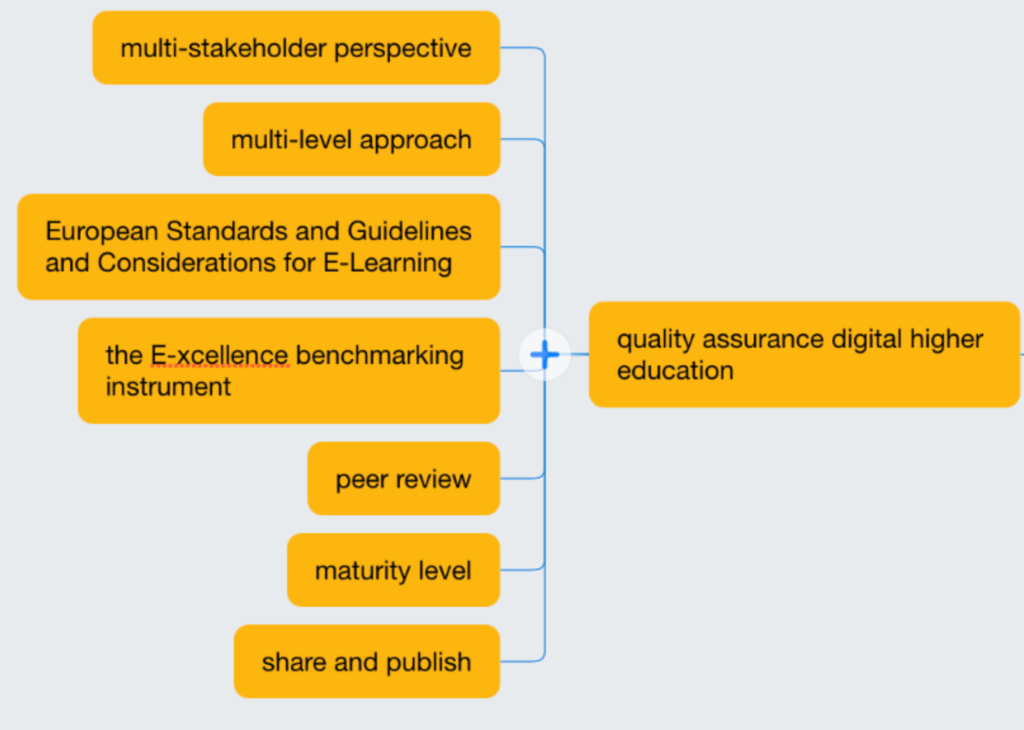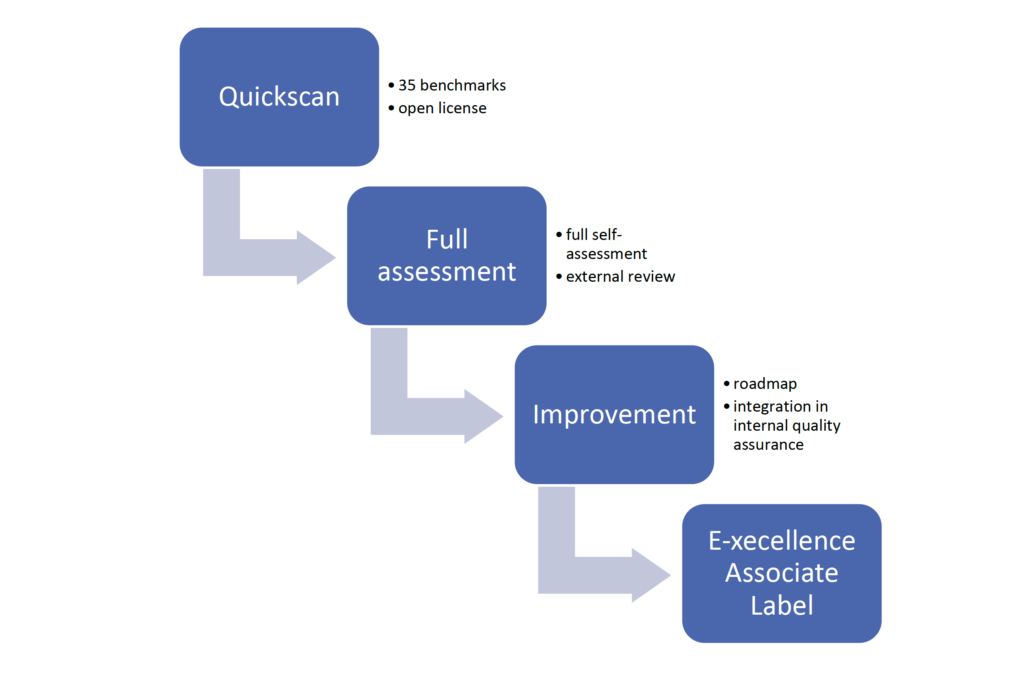
Digital higher education requires adapted quality assurance (fig. 25):
- there is a need for a multi-stakeholder perspective and a multi-level approach in quality assurance;
- the European Standards and Guidelines and the Considerations for E-learning provide a general
framework for quality assurance; - the E-xcellence benchmarking instrument provides tools for quality benchmarking and a manual with guidelines for improvement;
- the EMBED model assesses mature decision-making;
- peer review can contribute to quality before a course is started;
- digital higher education should adopt an education cycle, parallel to the research cycle, in which the
best course and programme designs are shared and published.
After the COVID crisis, digital higher education practices are growing in quantity and permeating higher education. They have also become more complex as various pedagogies are used in courses and programmes, such as synchronous hybrid, blended, and online education and distance learning.
Universities also organize a broader range of education. In addition to degree education, they offer
online programmes for continuing education, micro-credential courses, and open education through
MOOCs, all based on their mission.
The international dimension has also become important in all these areas. Universities organize joint
curricula and mobility schemes. This development has even been reinforced by the European
Commission’s European Universities Initiatives (EUIs), creating alliances across Europe.
Digital education plays an essential role in creating the new European pedagogical landscape. Already during the design process of digital courses and programmes, a quality assurance plan should be drawn up, building on internal quality assurance approaches of the higher education institution. The design team or programme board is responsible for the scientific content and the NQF/EQF level in terms of complexity of competences. Design models already contain criteria and procedures to achieve the highest possible quality. Therefore, to a large extent, in digital education, quality assured by design.
For internal and external quality assurance, appropriate approaches and tools are needed for institutions and quality and accreditation agencies.
Multi-stakeholder perspectives
From the point of view of quality assurance and quality improvement, it is important to take into account the perspectives of the different stakeholders, in particular:
- the learner’s perspective, related to dimensions such as the learner’s readiness for online learning,
the digital learning environment and learning resources, flexibility, and student support; - The perspective of the teaching staff and programme boards, related to organizational conditions
for digital course and curriculum design, the suitability of the learning environment for various
digital pedagogies, the availability of media and tools, frameworks for international course
collaboration and virtual mobility, and tools for e-assessment - The perspective of teaching and learning support services, related to digital course and
curriculum design, team support and ICT support; - The leadership perspective, related to institutional strategies and frameworks for the digitization
of education, quality assurance frameworks, institutional budgeting, the continuous professional
development of staff, continuous institutional evaluation and international collaboration and
mobility, notably in EUIs and higher education networks; - The external stakeholder perspective, related to the response to needs for flexible digital education
in enterprises, professions, and society, possibly the co-creation of content, flexible workplace
learning, and the recognition of qualifications for digital learning
Stakeholders’ perspectives may differ in mainstream education, continuing education and professional
development, and open education through MOOCs. It is therefore important to create specific internal
quality frameworks for these areas, although in practice they may interact with each other.
Multi-level approach
At the same time, a multilevel approach is important because change processes affect stakeholders at
their own level. To make change processes effective, these levels need to be in continuous dialog;
(Ubachs and Henderikx, 2022):
- the micro-level constitutes the course and curriculum with students and academic staff as key
players; - the meso-level refers to the institutional organization, with institutional leaders, support staff, and
representatives of external stakeholders as key actors; - The macro-level includes national and regional decision-makers related to the organization of
higher education, including national support services such as quality assurance agencies and ICT
infrastructure providers, councils, and stakeholder organisations.
Although processes at these levels are different, an integrated approach to quality and innovation must
involve stakeholders at all levels with their own perspectives and responsibilities.
European Standards and Guidelines and Considerations for E-learning
The European Network of Quality Assurance Agencies (ENQA) has developed the common Standards
and Guidelines for Quality Assurance in the European Higher Education Area (ESG, 2015), adopted
by the EHEA Ministerial Conference. These are applied by internal quality assurance bodies in the
universities and by national external quality assurance agencies. The ESG sees quality as “primarily a result of the interaction between teachers, students, and the institutional learning environment.” Quality assurance ensures that “programme content, learning opportunities and facilities are fit for purpose” and focuses on “all activities within the continuous improvement cycle of higher educa70 tion institutions” (ESG, p. 7).
A special ENQA Working Group decided has systematically examined both the applicability and
relevance of the standards as defined in the ESG 2015 for uses in digital education. While each
standard appeared to be fully applicable to e-learning, some seemed to require special guidelines on
how to apply them. Guidelines to use the ESG for digital offers, are published in the “Considerations
for Quality Assurance of E-learning Provisions” (Huertas et al., 2018)
The E-xcellence benchmarking instrument
The widely used E-xcellence instrument reflects a reference framework of benchmarks against which
digital courses and programmes and their support systems can be assessed (Ubachs et al., 2015).
Addressing all aspects of delivering high-quality digital education, E-xcellence clearly represents a
multilevel approach, targeting both staff and management levels under the manual’s six chapters on
strategic management, curriculum design, course design, course delivery, staff support, and student
support.
The E-xcellence label recognizes a continuous cycle of digital learning improvement by the university
(Williams, Kear, & Rosewell, 2016).
The E-xcellence manual provides guidance notes. It has also proved useful for designing, developing,
and implementing digital courses and programmes.
To date, more than 50 universities across Europe have used the E-xcellence tool to benchmark their
digital learning performance with peer review on site. The instrument is available in open license and
translated in several languages worldwide.
E-xcellence also includes a self-assessment benchmarking quick-scan survey, comparing university
performance with best practices in digital teaching and learning in Europe.
In the many exercises with E-xcellence benchmarking at European universities, the most important
feature mentioned is the guided discussion within the institution by using the tool. Not only does it
ensure that all necessary aspects of delivering high-quality online education are covered, but it
encourages university staff to reflect and discuss processes they take for granted or have not thought
about before.
The E-xcellence procedure for the quality label consists of three steps toward the E-xcellence label,
which recognizes a continuous cycle of e-learning improvement by the university.
The assessment allows the university to determine the performance of its current digital courses and
programmes and to identify the requirements for further improvement. After having first performed
the quick-scan on 35 benchmarks as a quick self-assessment, the university can opt for a more
extensive review assessment by experts. This can be done through either an online or a full on-site
assessment, with locally focused recommendations for improvement by the review team.
Building on the self-assessment, the university will develop an adequate roadmap with further
improvements to digital learning for the next three years. This roadmap is also assessed by the reviewers in consultation.
In order to guarantee a continuous cycle of self-evaluation of its digital learning performance as a university, the procedure includes the integration of the E-xcellence benchmarks into the internal quality assurance system. This is a requirement for obtaining the E-xcellence Associate in Quality Label from EADTU. E-xcellence offers also onsite reviews for ex post quality assurance.

Peer review
Typical for asynchronous online courses is that they can be evaluated by peers before they are implemented in real life. In many universities, this evaluation is a standard procedure in the development phase of a digital course, even when members of the course team have continuously discussed each others’ learning units beforehand.
Maturity level
The European Maturity Model for Blended Education (EMBED) can be used to assess the maturity
level of courses, programmes and institution-wide provisions for blended education. The concept of
maturity refers to the degree of regular deliberate optimization of the design of blended education and
evidence-based decision-making by the course team and individual teaching staff (EADTU, 2021a).
Share and publish
As education is a design science, it is good practice that teaching staff and course teams publish about
the design, the development and implementation of courses as is done in other design sciences (architecture, engineering, etc.). By sharing and publishing, teaching staff will level up their own ambitions and create a culture for developing quality courses in the higher education community. It should be the completion of the teaching cycle, just as publications are for research. (Laurillard, 2021). This is also applicable for micro-credentials.
Furthermore, micro-credential courses can be published in open educational resource databases or
courses can be made available for learners to learn at their own pace.
next chapter: Institutional policies for digital higher education
previous chapter: Online distance teaching and learning
back to overview: Models and guidelines for the design and development of
digital teaching and learning in higher education
